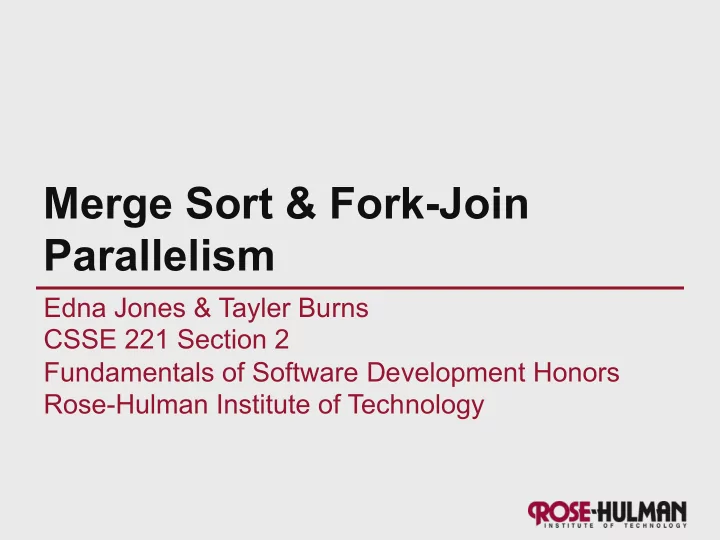

Merge Sort & Fork-Join Parallelism Edna Jones & Tayler Burns CSSE 221 Section 2 Fundamentals of Software Development Honors Rose-Hulman Institute of Technology
Merge Sort • Sorts usually from smallest to largest • Why sort a list? Sorted lists can use certain search algorithms. • Divides array in half recursively • Call merge sort on each half of the array • Then merges the sorted halves into a sorted array • Has O(n log n) efficiency
Comparing During Dividing the Array Merging
Video • http://www.youtube.com/watch? v=2sLHJpMyNXA&feature=player_detailp age
Coding Merge Sort
Classes Used in Fork-Join Parallelism • ForkJoinPool : use exactly one of these to run all your fork-join tasks in the whole program – It is the job of the pool to take all the tasks that can be done in parallel and actually use the available processors effectively. • RecursiveTask<V> : you run an object of type a subclass of this in a pool and have it return a result • RecursiveAction : just like RecursiveTask except it does not return a result • ForkJoinTask<V> : superclass of RecursiveTask<V> and RecursiveAction. fork() and join() are methods defined in this class. It is the class with most of the useful javadoc documentation, in case you want to learn about additional methods.
Using Fork-Join Parallelism • Create a ForkJoinPool – ForkJoinPool fjPool = new ForkJoinPool(); • Call the invoke() method on the ForkJoinPool passing an object of type RecursiveTask<V> – fjPool.invoke(new RecursiveTask<V>(Object o)); – This causes the ForkJoinPool to call the compute() method of the RecursiveTask. • The compute() method
Using Fork-Join Parallelism • Call fork() method on a RecursiveTask. This starts parallel computation – fork() itself returns quickly, but more computation is now going on. • When you need the answer, you call the join() method on the object you called fork() on. The join method will get you the answer from compute() that was figured out by fork(). If it is not ready yet, then join will block (i.e., not return) until it is ready.
Example
Things to Watch Out for • Don’t call fork twice for only two subproblems and then call join twice. This is much less efficient than just calling compute() and has no benefit since you are creating more parallel tasks than is helpful. • The order in which you call fork(), compute(), and join() matters – If you call the methods in the order fork(), join(), compute() or compute(), fork(), join(), the code won’t run in parallel.
Sources • Horstmann, Cay. Big Java . • “Beginner's Introduction to Java's ForkJoin Framework.” <http:// www.cs.washington.edu/homes/djg/ teachingMaterials/ grossmanSPAC_forkJoinFramework.html> • http://www.mycstutorials.com/articles/ sorting/mergesort
Recommend
More recommend